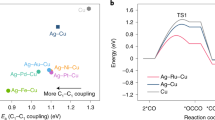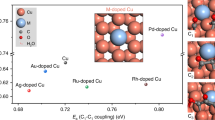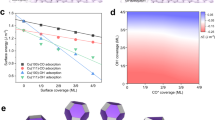Abstract
The electrosynthesis of C2+ hydrocarbons from CO2 has attracted recent attention in light of the relatively high market price per unit energy input. Today’s low selectivities and stabilities towards C2+ products at high current densities curtail system energy efficiency, which limits their prospects for economic competitiveness. Here we present a materials processing strategy based on in situ electrodeposition of copper under CO2 reduction conditions that preferentially expose and maintain Cu(100) facets, which favour the formation of C2+ products. We observe capping of facets during catalyst synthesis and achieve control over faceting to obtain a 70% increase in the ratio of Cu(100) facets to total facet area. We report a 90% Faradaic efficiency for C2+ products at a partial current density of 520 mA cm−2 and a full-cell C2+ power conversion efficiency of 37%. We achieve nearly constant C2H4 selectivity over 65 h operation at 350 mA cm−2 in a membrane electrode assembly electrolyser.
This is a preview of subscription content, access via your institution
Access options
Access Nature and 54 other Nature Portfolio journals
Get Nature+, our best-value online-access subscription
$29.99 / 30 days
cancel any time
Subscribe to this journal
Receive 12 digital issues and online access to articles
$119.00 per year
only $9.92 per issue
Buy this article
- Purchase on Springer Link
- Instant access to full article PDF
Prices may be subject to local taxes which are calculated during checkout




Similar content being viewed by others
Data availability
The datasets generated and/or analysed during the current study are available from the corresponding author on reasonable request.
References
Bushuyev, O. S. et al. What should we make with CO2 and how can we make it? Joule 2, 1–8 (2018).
Mistry, H., Varela, A. S., Kühl, S., Strasser, P. & Cuenya, B. R. Nanostructured electrocatalysts with tunable activity and selectivity. Nat. Rev. Mater. 1, 16009 (2016).
Schouten, K., Kwon, Y., Van der Ham, C., Qin, Z. & Koper, M. A new mechanism for the selectivity to C1 and C2 species in the electrochemical reduction of carbon dioxide on copper electrodes. Chem. Sci. 2, 1902–1909 (2011).
Hori, Y. Modern Aspects of Electrochemistry 89–189 (Springer, 2008).
Wang, Y., Liu, J., Wang, Y., Al-Enizi, A. M. & Zheng, G. Tuning of CO2 reduction selectivity on metal electrocatalysts. Small 13, 1701809 (2017).
Hoang, T. T. H., Ma, S., Gold, J. I., Kenis, P. J. A. & Gewirth, A. A. Nanoporous copper films by additive-controlled electrodepsition: CO2 reduction catalysis. ACS Catal. 7, 3313–3321 (2017).
De Luna, P. et al. Catalyst electro-redeposition controls morphology and oxidation state for selective carbon dioxide reduction. Nat. Catal. 1, 103–110 (2018).
Mistry, H. et al. Highly selective plasma-activated copper catalysts for carbon dioxide reduction to ethylene. Nat. Commun. 7, 12123 (2016).
Hoang, T. T. H. et al. Nano porous copper-silver alloys by additive-controlled electro-deposition for the selective electroreduction of CO2 to ethylene and ethanol. J. Am. Chem. Soc. 140, 5791–5797 (2018).
Zhuang, T.-T. et al. Steering post-C–C coupling selectivity enables high efficiency electroreduction of carbon dioxide to multi-carbon alcohols. Nat. Catal. 1, 421–428 (2018).
Li, C. W., Ciston, J. & Kanan, M. W. Electroreduction of carbon monoxide to liquid fuel on oxide-derived nanocrystalline copper. Nature 508, 504–507 (2014).
Jiang, K. et al. Metal ion cycling of Cu foil for selective C–C coupling in electrochemical CO2 reduction. Nat. Catal. 1, 111–119 (2018).
Li, C. W. & Kanan, M. W. CO2 reduction at low overpotential on Cu electrodes resulting from the reduction of thick Cu2O films. J. Am. Chem. Soc. 134, 7231–7234 (2012).
Reller, C. et al. Selective electroreduction of CO2 toward ethylene on nano dendritic copper catalysts at high current density. Adv. Energy Mater. 7, 1602114 (2017).
Pérez Gallent, E., Marcandalli, G., Figueiredo, M. C., Calle-Vallejo, F. & Koper, M. Structure- and potential-dependent cation effects on CO reduction at copper single-crystal electrodes. J. Am. Chem. Soc. 139, 16412–16419 (2017).
Pérez Gallent, E., Figueiredo, M. C., Calle-Vallejo, F. & Koper, M. Spectroscopic observation of a hydrogenated CO dimer intermediate during CO reduction on Cu(100) electrodes. Angew. Chem. Int. Ed. 56, 3621–3624 (2017).
Hori, Y., Takahashi, I., Koga, O. & Hoshi, N. Electrochemical reduction of carbon dioxide at various series of copper single crystal electrodes. J. Mol. Catal. A: Chem. 199, 39–47 (2003).
Roberts, F. S., Kuhl, K. P. & Nilsson, A. High selectivity for ethlyene from carbon dioxide reduction over copper nanocube electrocatalysts. Angew. Chem. Int. Ed. 54, 5179–5182 (2015).
Jin, M. et al. Shape-controlled synthesis of copper nanocrystals in an aqueous solution with glucose as a reducing agent and hexadecylamine as a capping agent. Angew. Chem. Int. Ed. 50, 10560–10564 (2011).
Huang, J. et al. Potential-induced nanoculstering of metallic catalysts during electrochemcial CO2 reduction. Nat. Commun. 9, 3117 (2018).
Tran, R. et al. Surface energies of elemental crystals. Sci. Data 3, 160080 (2016).
Droog, J. M. M. & Schlenter, B. Oxygen electrosorption on copper single crystal electrodes in sodium hydroxide solution. J. Electroanal. Chem. 112, 387–390 (1980).
Raciti, D. et al. Low-overpotential electroreduction of carbon monoxide using copper nanowires. ACS Catal. 7, 4467–4472 (2017).
Yin, Y. & Alivisatos, A. P. Colloidal nanocrystal synthesis and the organic–inorganic interface. Nature 437, 664–670 (2005).
Zhuang, T.-T. et al. 1D colloidal hetero-nanomaterials with programmed semichonductor morphology and metal location for enhancing solar energy conversion. Small 13, 1602629 (2017).
Dinh, C.-T. et al. CO2 electroreduction to ethylene via hydroxide-mediated copper catalysis at an abrupt interface. Science 360, 783–787 (2018).
Cheng, T., Xiao, H. & Goddard, W. A. III Nature of the active sites for CO reduction on copper nanoparticles; suggestions for optimizing performance. J. Am. Chem. Soc. 139, 11642–11645 (2017).
Liu, X. et al. Understanding trends in electrochemical carbon dioxide reduction rates. Nat. Commun. 8, 15438 (2017).
Reske, R., Mistry, H., Behafarid, F., Roldan Cuenya, B. & Strasser, P. Size effects in the catalytic electroreduction of CO2 on Cu nanoparticles. J. Am. Chem. Soc. 136, 6978–6986 (2014).
Huang, X. et al. Freestanding palladium nanosheets with plasmonic and catalytic properties. Nat. Nanotechnol. 6, 28–32 (2011).
Kang, Y., Ye, X. & Murray, C. B. Size- and shape-selective synthesis of metal nanocrytals and nanowires using CO as a reducing agent. Angew. Chem. Int. Ed. 49, 6156–6159 (2010).
Cui, C. et al. Carbon monoxide-assisted size confinement of bimetallic alloy nanoparticels. J. Am. Chem. Soc. 136, 4813–4816 (2014).
Kresse, G. & Furthmüller, J. Efficient iterative schemes for ab initio total-energy calculations using a plane-wave basis set. Phys. Rev. B 54, 11169–11186 (1996).
Kresse, G. & Furthmuller, J. Efficiency of ab-initio total energy calculations for metals and semiconductors using a plane-wave basis set. Comp. Mater. Sci. 6, 15–50 (1996).
Kresse, G. & Hafner, J. Ab-Initio molecular-dynamics simulation of the liquid-metal amorphous-semiconductor transition in Germanium. Phys. Rev. B 49, 14251–14269 (1994).
Kresse, G. & Hafner, J. Ab initio molecular dynamics for liquid metals. Phys. Rev. B 47, 558–561 (1993).
Perdew, J. P., Burke, K. & Ernzerhof, M. Generalized gradient approximation made simple. Phys. Rev. Lett. 77, 3865–3868 (1996).
Kresse, G. & Joubert, D. From ultrasoft pseudopotentials to the projector augmented-wave method. Phys. Rev. B 59, 1758–1775 (1999).
Blöchl, P. E. Projector augmented-wave method. Phys. Rev. B 50, 17953–17979 (1994).
Grimme, S., Antony, J., Ehrlich, S. & Krieg, H. A consistent and accurate ab initio parametrization of density functional dispersion correction (DFT-D) for the 94 elements H–Pu. J. Chem. Phys. 132, 154104 (2010).
Grimme, S., Ehrlich, S. & Goerigk, L. Effect of the damping function in dispersion corrected density functional theory. J. Comp. Chem. 32, 1456–1465 (2011).
Michaelides, A. et al. Identification of general linear relationships between activation energies and enthalpy changes for dissociation reactions at surfaces. J. Am. Chem. Soc. 125, 3704–3705 (2003).
Liu, Z. P. & Hu, P. General rules for predicting where a catalytic reaction should occur on metal surfaces: A density functional theory study of C–H and C–O bond breaking/making on flat, stepped, and kinked metal surfaces. J. Am. Chem. Soc. 125, 1958–1967 (2003).
Alavi, A., Hu, P. J., Deutsch, T., Silvestrelli, P. L. & Hutter, J. CO oxidation on Pt(111): an ab initio density functional theory study. Phys. Rev. Lett. 80, 3650–3653 (1998).
Montoya, J. H., Shi, C., Chan, K. & Nørskov, J. K. Theoretical insights into a CO dimerization mechanism in CO2 electroreduction. J. Phys. Chem. Lett. 6, 2032–2037 (2015).
van Duin, A. C. T. et al. Development and validation of a reaxFF reactive force field for Cu cation/water interactions and copper metal/metal oxide/metal hydroxide condensed phases. J. Phys. Chem. A 114, 9507–9514 (2010).
Cheng, T., Xiao, H. & Goddard, W. A. Full atomistic reaction mechanism with kinetics for CO reduction on Cu(100) from ab initio molecular dynamics free energy calculation at 298 K. Proc. Natl Acad. Sci. USA 114, 1795–1800 (2017).
Sundararaman, R. & Goddard, W. A. III The charge-asymmetric nonlocally determined local-electric (CANDLE) solvation model. J. Chem. Phys. 142, 064107 (2015).
Xiao, H., Cheng, T. & Goddard, W. A. III Atomistic mechanisms underlying selectivities in C1 and C2 products from electrochemical reduction of CO on Cu(111). J. Am. Chem. Soc. 139, 130–136 (2017).
Sundararaman, R., Goddard, W. A. II & Arias, T. A. Grand canonical electronic density-functional theory: algorithms and applications to electrochemistry. J. Chem. Phys. 146, 114104 (2017).
Sundararaman, R. et al. JDFTx: software for joint density-functional theory. SoftwareX 6, 278–284 (2017).
Ong, S. P. et al. Python Materials Genomics (pymatgen): a robust, open-source python library for materials analysis. Comp. Mater. Sci. 68, 314–319 (2013).
Verdaguer-Casadevall, A. et al. Probing the active surface sites for CO reduction on oxide-derived electrocatalysts. J. Am. Chem. Soc. 137, 9808–9811 (2015).
Millero, F. J. & Rabindra, N. R. A chemical equilibrium model for the carbonate system in natural waters. Croat. Chem. Acta 70, 1–38 (1997).
COMSOL Multiphysics v. 5.3a (COMSOL AB, 2017); www.comsol.com
Millero, F. J., Graham, T. B., Huang, F., Bustos-Serrano, H. & Pierrot, D. Dissociation constants of carbonic acid in seawater as a function of salinity and temperature. Mar. Chem. 100, 80–94 (2006).
Weisenberger, S. & Schumpe, A. Estimation of gas solubilities in salt solutions at temperatures from 273 K to 363 K. AIChE J. 42, 298–300 (1996).
Mehrbach, C., Culberson, C. H., Hawley, J. E. & Pytkowicx, R. M. Measurement of the apparent dissociation constants of carbonic acid in seawater at atmospheric pressure. Limnol. Oceanogr. 18, 897–907 (1973).
Burdyny, T. et al. Nanomorphology-enhanced gas-evolution intensifies CO2 reduction electrochemistry. ACS Sustain. Chem. Eng. 5, 4031–4040 (2017).
Ravel, B. & Newville, M. ATHENA, ARTEMIS, HEPHAESTUS: data analysis for X-ray absorption spectroscopy using IFEFFIT. J. Synchrotron Rad. 12, 537–541 (2005).
Li, J. et al. Revealing the synergy of mono/bimetallic PdPt/TiO2 heterostructure for enhanced photoresponse performance. J. Phys. Chem. 121, 24861–24870 (2017).
Luc, W., Rosen, J. & Jiao, F. An Ir-based anode for a practical CO2 electrolyzer. Catal. Today 288, 79–94 (2017).
Acknowledgements
This work was supported financially by TOTAL American Services, the Connaught Fund, the Ontario Research Fund: Research Excellence Program, the Natural Sciences and Engineering Research Council of Canada and the CIFAR Bio-inspired Solar Energy programme. This research used synchrotron resources from the Advanced Photon Source (an Office of Science User Facility operated for the US Department of Energy) Office of Science by Argonne National Laboratory, supported by the US Department of Energy under contract no. DE-AC02-06CH11357) and the Canadian Light Source and its funding partners. All DFT computations were performed on the IBM BlueGene/Q supercomputer with support from the Southern Ontario Smart Computing Innovation Platform and Niagara supercomputer at the SciNet HPC Consortium. Southern Ontario Smart Computing Innovation Platform is funded by the Federal Economic Development Agency of Southern Ontario, the Province of Ontario, IBM Canada, Ontario Centres of Excellence, Mitacs and 15 Ontario academic member institutions. SciNet is funded by the Canada Foundation for Innovation; the Government of Ontario; Ontario Research Fund—Research Excellence; and the University of Toronto. We acknowledge the Toronto Nanofabrication Centre and the Ontario Centre for the Characterization of Advanced Materials for sample preparation and characterization facilities. The authors thank T. P. Wu, Z. Finfrock and L. Ma for technical support at 9BM beamline of the Advanced Photon Source. The authors also thank D. Jiang, N. Chen, C. Kim and W. Chen for their assistance at the HXMA beamline at the Canadian Light Source. D.S. acknowledges the Natural Sciences and Engineering Research Council of Canada—E.W.R Steacie Memorial Fellowship. A.S. acknowledges Fonds de Recherche du Quebec-Nature et Technologies for the postdoctoral fellowship award. J.L. and M.G.K. acknowledges the Banting postdoctoral fellowship from the Government of Canada. C.M.G. acknowledges Natural Sciences and Engineering Research Council of Canada for funding in the form of a postdoctoral fellowship. We acknowledge L. Huang and G. Zheng for the help in Brunauer–Emmett–Teller measurements and data analysis. We acknowledge D. Kopilovic for designing flow electrolysers. We thank M. Chekini and E. Kumachev for the help in dynamic light scattering measurements.
Author information
Authors and Affiliations
Contributions
E.H.S. supervised the project. Y.W. and C.-T.D. designed the experiments. Y.W. carried out the catalyst synthesis, electrochemical tests, electrocatalysis tests and SEM measurements. Z.W. performed DFT calculations. J.L. performed all the XAS measurements and analysed the results. A.O. performed the tests in MEA electrolysers. M.G.K. prepared evaporated copper seeds. Y.L. and F.L. prepared sputtered copper seeds. C.-S.T. performed TEM measurements and data analysis. A.S. and C.M.G. carried out the operando Raman measurements. M. Luo synthesized copper nanocubes. C.M. performed the local pH simulations. Y.W., H.Z., M.Liu, A.P. and A.J. performed GIWAXS measurements and data analysis. Y.X. designed flow channels for electrolysers. A.P. and P.T. carried out the XPS measurements. T.-T.Z., S.O.K. and D.S. contributed to manuscript writing. All authors discussed, commented on and revised the manuscript.
Corresponding author
Ethics declarations
Competing interests
Y.W. and E.H.S. of the University of Toronto have filed provisional patent application no. 62/844,482 regarding the preparation of in-situ synthesized catalysts for CO2 reduction.
Additional information
Publisher’s note Springer Nature remains neutral with regard to jurisdictional claims in published maps and institutional affiliations.
Supplementary information
Supplementary Information
Supplementary Figs. 1–44, Tables 1–19 and references.
Supplementary Data 1
Atomic coordinates of the optimized computational models.
Rights and permissions
About this article
Cite this article
Wang, Y., Wang, Z., Dinh, CT. et al. Catalyst synthesis under CO2 electroreduction favours faceting and promotes renewable fuels electrosynthesis. Nat Catal 3, 98–106 (2020). https://doi.org/10.1038/s41929-019-0397-1
Received:
Accepted:
Published:
Issue Date:
DOI: https://doi.org/10.1038/s41929-019-0397-1
This article is cited by
-
Site-selective protonation enables efficient carbon monoxide electroreduction to acetate
Nature Communications (2024)
-
Complementary probes for the electrochemical interface
Nature Reviews Chemistry (2024)
-
In situ copper faceting enables efficient CO2/CO electrolysis
Nature Communications (2024)
-
Mechanistic insights into C-C coupling in electrochemical CO reduction using gold superlattices
Nature Communications (2024)
-
A surface strategy boosting the ethylene selectivity for CO2 reduction and in situ mechanistic insights
Nature Communications (2024)



